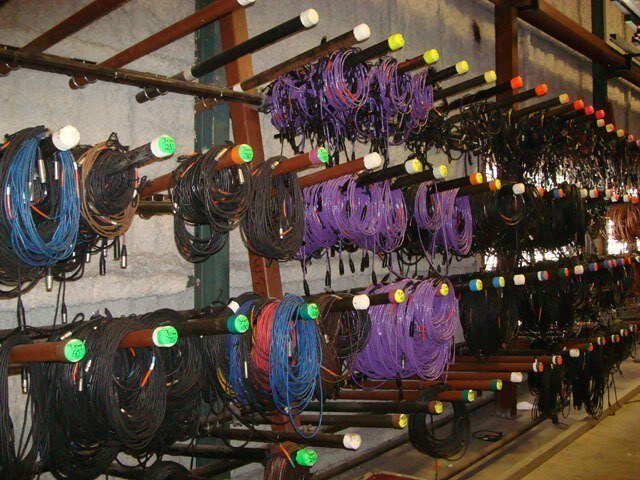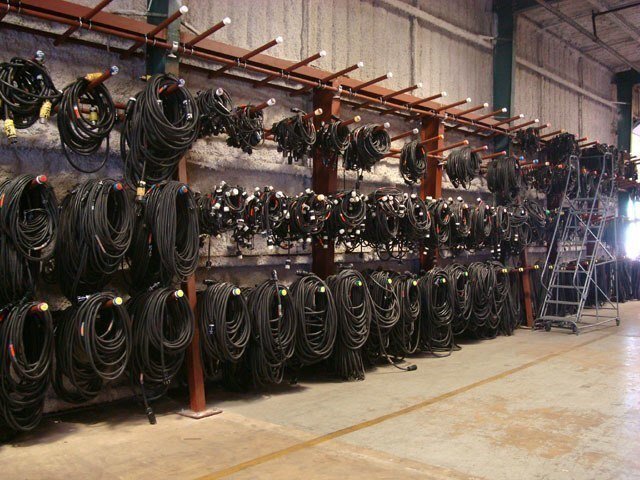The electrnics color code is fairly common, too bad it didn't catch on in the industry back in the like 70's or before when such concepts came out. This topic has also been discussed before should you want more research into the subject.
Stuff like as above problem of if electronics color code when your cable lengths don't match up with another companies color code that just don't
stock that length of cable. Might especially be problematic between lighting and sound companies based on the metric or imperial systems.
Where I work we use a different color code than that above and like eight years ago, it took practically an act of God to convert 15' cables from the stupid white/red to a more simple red. Even heard a problem with it of... "how than if now red for 15' can we tell the difference between 15' and 75'?" urr... gee, self evidant?
Where I work, cable colors got really complex in even running out of colors - overall color verses stripe of color even above a length color code so as to designate what it's for. Got our basic color code - 5' = yellow for instance. This by way of pre-printed
heat shrink labels with company name and phone number. Such imprinted lablels often wear off with use so they are always not just covered with
clear heat shrink, but that
heat shrink is glued to the cable so it does't have flexibility/wear problems after a few years.
Add to that on a common cable that I recognize that nobody uses the same color code for length. Some do post a very useful color code inside their
road cases so those pulling the cable can figure out how long it is dependant on color. Very useful, never got much into it but very useful for the often IA types that work for many companies when on site without standardazation.
Instead I have gone to
P-Touch labeling all or at least most of my cable above the color coded for length cable. 8pt text for such a labeler that cable's serial number, as important for
tracking as with it's bar-code that I normally
throw away if servicing the cable. Never got into the bar code
system but it is policy. Also of 8pt text if 208v cable is a 208v. label which normally don't get a serial number. This differenciates it from the 120v stuff and is in general a warning.
Than as often added to a pre-printed for company and phone number cable lenth is it's description code in 4pt text. This on most cable other than that which I don't care about as much or don't have room. I do a specification of the cable
line in telling what it is. 12/3 SJ (OOW at times left out in only SJ verses SO most noted), 12/3 SJ. 50'. Or should it say be a
multi-cable, say 12/14 ProPlex 50' as noted the same info -
gauge,
conductor, brand or class than length. This length as listed on most all cables is especially useful to the roadies on-site but the other info is also important should they be doing their lamp load calculations in doing their job in say not making a 14ga. cable do a 20A load.
Been a problem in the past before I went all 12 ga. cable for use.
l
Anyway, those are the top two lines of info. Under company name and phone number on
multi cable,
hoist cable and for many others, I'll also list the date it was made and initials of who made it. All this atop a color for length
heat shrink and under a glued down
clear heat shrink so as to preserve the info. Takes more time and money to do it that way, but the info is preserved.
Our
system is arcaic in some ways in not using all colors and in limited by colors before my time for cable length. Sometimes say for a 150' cable it's both blue and yellow for color code. Should it be a length of 150' 1Kw
Soco cable for instance, it's going to have three colors to it. Yellow/blue and two purple stripes on the edges. (Those designing the origional color code
system date back 20 or 30 years in being un-imaganitive in a
system I'm now stuck with.) Purple stripes at the ends of a length color code denote that this cable is either 1Kw cable or 208v cable. Both have the same stripe
pattern and
system though the
Soco cable can be used in either 120v or 208v way.
Such stripes make you note things - not always understand what it means but you do note it. Once the company ran out of colors in not using all that many in even ROYGBV in color code as also done, they started double stripeing cable.. 175' is say Red/Blue... Makes sense to us.. but 200' is black as with use on adaptors,
fixture colors
etc.. I introduced the blue color code to S-4
Leko's once the 750w was introduced and it was needed to know what was still 575w verses 750w. Also introduced a write on of the date of the fixure on that label for the cap at least in assuming resale of the oldest fixtures and or
tracking down bad lot numbers. Got some metric fixtures by mistake and or crappy lot of them in
tracking them down. Date your gear by making it and who or by factory in at times you do get bad gear and need to
track it down.
This if not "bad employee" not fully tightening down
terminal screws, and all cable with that person's initals need to be returned for inspection.
Anyway, I digress, color coding is good. Used to be at work the same color code for length of cable for 3-pin
XLR cable as 5-pin
DMX cable. This before my time, they found some inventory problems with proper re-stock of them so in un-used color in the color code, started marking 5-pin cable no matter the length with green
velcro. This as opposed to normal data cable that gets
velcro of similar color to it's lenght. (For some reason they in the past as with purple or orange, never used green for a length code.) Orange for me is a caution color, purple I cannot get
heat shrink for but I
play with in tape at times, green?)
Anyway they did all the five pin stuff with green
heat shrink. Worked as a concept until someone on a constant basis removed the green
Velcro from the cable as many do in common with all
velcro on cables... gone in often just throwning out in not realizing how many hundreds of dollars per show they just cut off or tossed out. Hmm...
velcro in my way, remove it at like over $1.50 each and probably even more each removed over the years. Sorry if the
Velcro was in your way, did you have to destroy it or toss it out never really got
thru to the tour types in costing hundreds of dollars per year to providing a marking of the cable and also to just band it above tie
line.
Anyway, became appairent that
velcro wasn't working out for use of either wrapping cable - though still in use, but no longer relied upon in marking the cable. Instead I introduced the single stripe of color under the
heat shrink concept - in the past it was a double stripe, mine was a single stripe in a chotic
system.
All true 2-pair five pin
XLR cable now got a green stripe in the rest either not true five pin or older cable now circulating out of the inventory as it fails. Replaces the need for green velco for the five pin stuff unless five pin and
velcro removed in people having to inspect what they put away anway... and or in pulling for a show, having to explain that if if five pin, if it has a green stripe at the label, all five pins should work, otherwise without a green stripe and unless specifically requested, pins one
thru three in working is fine. Lots of non-green stripe cable returned as bad given pins 4&5 don't work but that's a more eduction type of thing as normal with how many amps a 100' 16/3 SJT cable can carry.
Ran out of colors of stripe at some
point especially when it came to the two versions of six pin cable.
RFU, Sensor,
Clear Com, or other purpose? About the same time
LED fixtures and other four pin gear became popular in me having to differentuate between Color Blast cable, verses
Clear Com,
Chroma Q, Color Ram or in general
scroller cable. Ran out of color stripes for them also given versions amongst others. Color stripe near the lenght of cable color code works well as a concpt but after I went copper, aluminum and even
masking tape in color - and I do have a baby blue verses normal blue color... gets complex not just to remember the code but to find more colors for new special cables.
All this said, it is a code and when I have time and mostly I don't just rely on color codes or mutiples of them, I label what it is and how long it is. Who owns it with a phone number, and if important, who made it and it's date.
This all as got complex given many cables - pallets of each length and I cannot imagine how many given any length of them might reach into the 3 or 400's for serial number, for my personal use, I use what I learned in college and works better in my own gear for me.
As stated in the past about this question, I use
e-Tape to
mark who owns the cables and it's lenght. My gear is 3M bably bue and many of my tools even still have that marking. One color of
E-tape as my color in not knowing anyone else around with that color and or as per college, one color of tape per where this cable,
fixture, or tool belongs to. Graned even if sparkley pink
nail polish in marking the tool,
fixture or cable, gotta know who owns that color before one has a hope of getting it returned thus the engraved name also.
Still though after color as to what theater the cable belonged to was their
system I use and with a sort of Roman Numerals
system can still about 20 years since I was introuced to the
system... still can easily read.
Assuming a 3/4" wide strip of tape, it in a Roman Numerals type way of marking makes it easy to read how long this cable is. One 3/4" width is ten
foot. Half that in width is 5'. Double that width is 50'. Count the rings on this cable and it's very easy to figure out how long this cable is. While at work I use one
system, at home and for my own gear, I use the more sensible
system. Count the rings. This assuming like 20 years ago I printed up and placed under packaging tape my name and (very old) phone number to what I own also. Taped color code that would be better under glued down
clear heat shrink in protecting the info, but I don't use the cable that much these days. I own my cable though and at a glance can easily determine it's lenght by way of counting the rings. Another
system that I prefer in reality. Count the growth rings.




